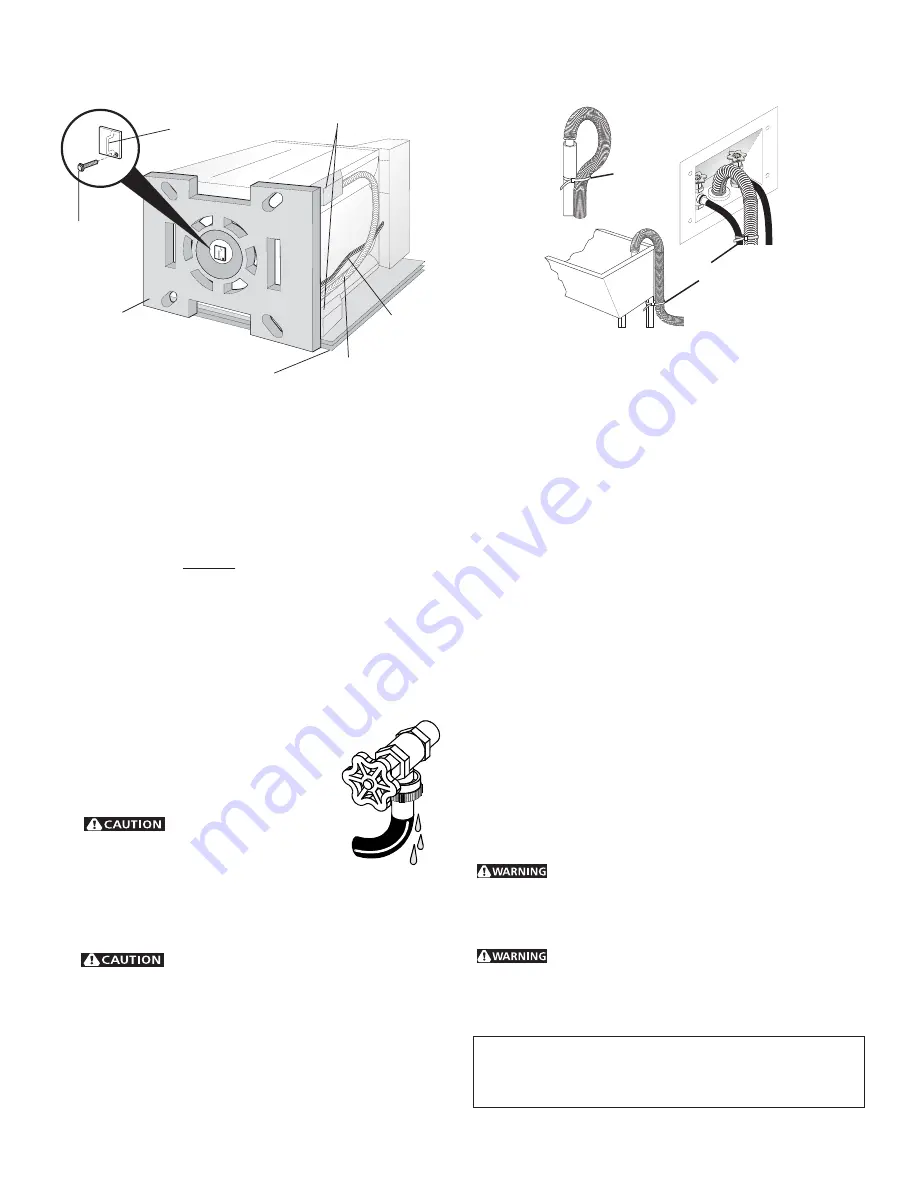
3
NOTE:
If the washer is to be transported at a later date, the
tub blocking pad, shipping bolt, and plastic spacer
block should be retained.
3.
Return the washer to an upright position.
4.
Remove the tape holding the lid shut and open the lid.
5.
Remove the foam tub blocking pad.
6.
Remove the inlet hoses (some models have inlet hoses already
attached to the water valve) and enclosure package from the
tub.
7.
From the back of the washer, remove the wire shipping clips
securing the drain hose and power cord. On some models,
PLASTIC CLAMPS secure the drain hose to the right side of the
washer backsheet. These clamps form a standpipe to prevent
water siphoning.
DO NOT REMOVE THESE CLAMPS.
8.
Carefully move the washer to within 4 feet of the final location
for the start of the installation.
INSTALLATION
1.
Run some water from the hot and cold faucets to flush the
water lines and remove particles that might clog up the water
valve screens.
2.
Check inlet hoses to ensure that the rubber washers are installed
in each end (If your washer has inlet hoses already attached to
the water valve, proceed to step 4).
3.
Carefully connect the inlet hoses to the water
valve (on the left side of the washer cabinet),
tighten by hand, then tighten another 2/3
turn with pliers.
DO NOT CROSS THREAD
OR OVERTIGHTEN THESE
CONNECTIONS.
4.
Determine which water faucet is the
HOT
water faucet and
carefully connect the bottom inlet hose to the
HOT
water faucet,
tighten by hand, then tighten another 2/3 turn with pliers.
Carefully connect the top inlet hose to the
COLD
water faucet,
tighten by hand, then tighten another 2/3 turn with pliers.
DO NOT CROSS THREAD OR
OVERTIGHTEN THESE CONNECTIONS.
Turn the water on and check for leaks at both connections.
5.
Carefully move the washer to its final location.
6.
To ensure the washer is level and solid on all four legs, open the
lid, grasp the top panel and tilt the washer forward so the rear
legs are off the ground. Gently set the washer back down to
allow the rear legs to self adjust. Place a level on top of the
washer. Check it side to side, then front to back. Screw the front
leveling legs up or down to ensure the washer is resting solid
on all four legs (no rocking of the washer should exist).
NOTE:
Keep the leg extension at a minimum to prevent
excessive vibration. The farther out the legs are
extended the more the washer will vibrate.
7.
Form a "U" shape on the end of the drain hose with the hose
pointed toward the drain. On some models, a wire retainer needs
to be assembled on the hose in that position. Place the formed
end in a laundry tub or a standpipe and secure with a cable tie
provided in the enclosure package.
NOTE:
The standpipe inside diameter must be 1-1/4" (3.18
cm) minimum. There must be an air gap around the
drain hose in the standpipe. A snug hose fit can
cause a siphoning action.
8. Plug the power cord into a grounded outlet.
NOTE:
Check to ensure the power is off at a circuit breaker/
fuse box before plugging the power cord into an
outlet.
9. Turn on the power at a circuit breaker/fuse box.
10. Read the Operating Instructions and Owner’s Guide provided
with the washer. They contain valuable and helpful information
that will save you time and money.
11. Run the washer through a complete cycle. Check for water leaks
and proper operation.
12. If your washer does not operate, please review the “Avoid Service
Checklist” located in your Owner’s Guide before calling for
service.
13. Place these instructions in a location near the washer for future
reference.
NOTE:
A wiring diagram is located inside the washer
console.
MECHANISM
S H I P P I N G
B O LT
P L A S T I C
S PA C E R
B L O C K
SHIPPING BLOCKS
DRAIN HOSE
P O W E R
C O R D
FOAM
S H I P P I N G
PA D
SHIPPING CARTON
CORNER POSTS
CABLE TIE
CABLE TIE
REPLACEMENT PARTS
If replacements parts are needed for your washer, contact the source
where you purchased your washer, call 1-800-944-9044, or visit
our website, www.frigidaire.com, for the Frigidaire Company
Authorized Parts Distributor nearest you.
Destroy the carton and plastic bags after the washer is
unpacked. Children might use them for play. Cartons covered with
rugs, bedspreads, or plastic sheets can become airtight chambers
causing suffocation. Place all materials in a garbage container or
make materials inaccessible to children.
The instructions in this manual and all other literature
included with this washer are not meant to cover every possible
condition and situation that may occur. Good safe practice and
caution
MUST
be applied when installing, operating and
maintaining any appliance.
Maximum benefits and enjoyment are achieved when all the
Safety and Operating instructions are understood and practiced
as a routine with your laundering tasks.




























